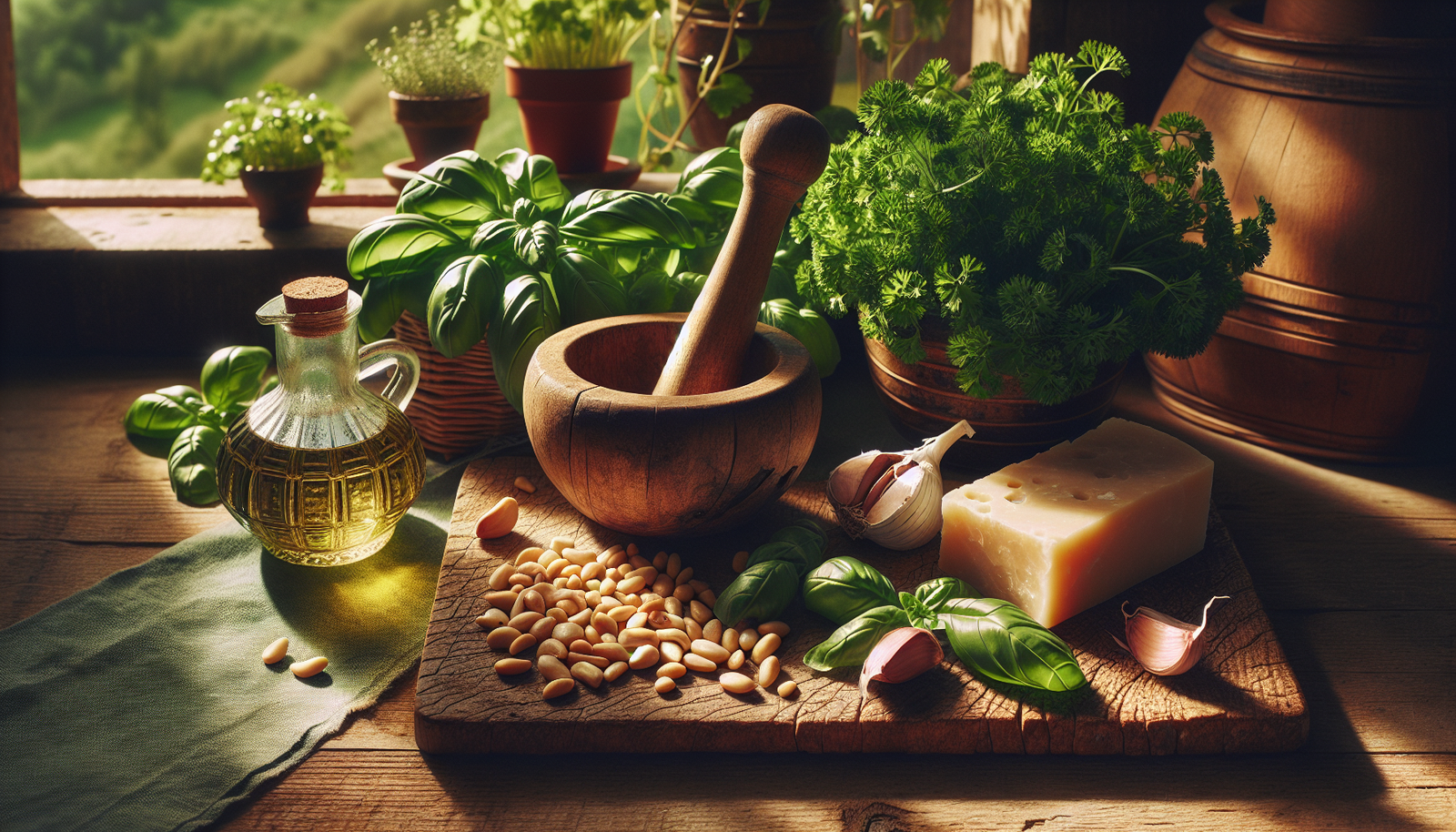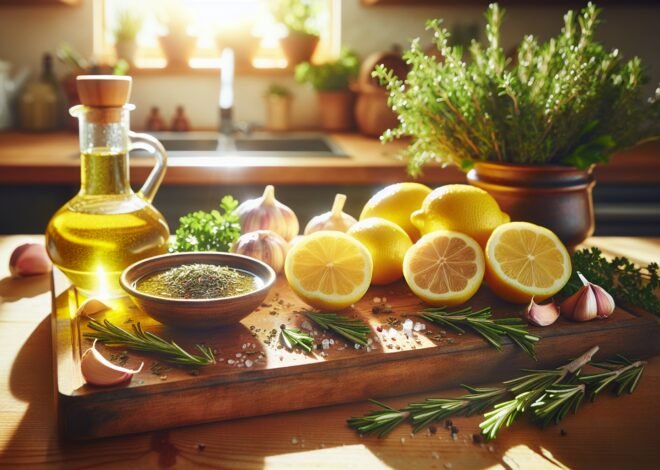
How to Make Fresh Pesto Using Basil and Other Herbs
Make fresh pesto, and transform simple ingredients into a culinary delight. This classic Italian sauce, typically made with basil, offers a burst of flavor to pasta, sandwiches, and more. While basil is the traditional herb, experimenting with alternative greens like parsley or arugula can yield exciting variations. With just a few core ingredients such as fresh herbs, nuts, garlic, Parmesan, and olive oil, you can create a homemade pesto that far exceeds store-bought versions. Discover how easy it is to customize this versatile condiment to suit your taste, turning everyday dishes into gourmet experiences.
Ingredients for Making Fresh Pesto
Crafting the perfect pesto starts with selecting high-quality ingredients. Each component contributes to the flavor, texture, and aroma that make this Italian staple a favorite worldwide. From the freshest herbs to the finest olive oil, every element plays a crucial role.
Essential Herbs and Greens for Pesto
The vibrant heart of pesto lies in its herbs and greens. Traditionally, basil is the classic choice, offering a sweet and slightly peppery flavor. For an aromatic twist, consider incorporating other greens like spinach, arugula, or even kale. These alternatives not only add a unique taste but also boost the nutritional profile. To ensure fresh pesto, opt for organically grown herbs whenever possible. Their bright color and strong aroma are indicators of good quality. Make sure to rinse them thoroughly to remove any dirt or pesticides.
Selecting the Best Olive Oil for Pesto
Olive oil is more than just a binding agent in pesto; it infuses the sauce with a rich, fruity undertone. Extra virgin olive oil is the best choice for its superior flavor and health benefits. Its cold-pressed nature retains more nutrients and offers a robust taste that complements the herbs perfectly. When selecting olive oil, look for labels indicating a recent harvest date to ensure freshness. Sampling a small amount can help gauge its flavor profile, looking for a balance of fruity, bitter, and pungent notes.
Choosing the Right Nuts for Texture
Nuts add a delightful crunch and creaminess to pesto. Pine nuts are the traditional choice, providing a buttery texture that melds seamlessly with other ingredients. However, don’t shy away from experimenting with alternatives like walnuts, almonds, or cashews. Each type of nut brings a distinct flavor and texture to the mix. Toasting the nuts lightly before blending can enhance their flavor, making them more aromatic. Always opt for unsalted nuts to maintain control over the final seasoning of your pesto.
Step-by-Step Guide to Pesto Preparation
Making pesto from scratch is both rewarding and straightforward. The process enhances the flavors of each ingredient, resulting in a sauce that’s fresh and vibrant. Follow these steps to create a pesto that’s both smooth and delicious.
Prepping Ingredients for Homemade Pesto
Preparation is key to achieving a well-balanced pesto. Begin with washing and drying your chosen herbs and greens thoroughly. Patting them dry prevents excess moisture from diluting the sauce. Measure your ingredients carefully to maintain the right balance of flavors. For the nuts, toasting them in a skillet over medium heat until golden can release oils and deepen their flavor. Grating fresh Parmesan cheese can also make a notable difference compared to pre-grated options.
Blending Techniques for Smooth Pesto
Achieving the ideal pesto texture depends significantly on your blending technique. Start by adding nuts and garlic to a food processor; pulse until finely chopped. Gradually add herbs, followed by a steady stream of olive oil, while the processor runs. This method ensures a creamy emulsion. Season with salt and freshly ground black pepper to taste. Avoid over-blending, as it may cause the sauce to heat up and lose its vibrant green color. For those who prefer a rustic texture, consider using a mortar and pestle for a more traditional preparation.
Tips for Adjusting Pesto Flavor and Consistency
Fine-tuning the flavor and consistency of your pesto can elevate it to new heights. If the pesto tastes too bitter, a splash of lemon juice can balance it out. For a creamier texture, consider adding more olive oil or a touch of cream. To thicken a runny pesto, incorporate more cheese or nuts. Seasoning is crucial; taste your pesto frequently and adjust the salt and pepper accordingly. If you prefer a piquant flavor, a pinch of red pepper flakes can add a spicy kick.
Creative Ways to Use Homemade Pesto
Pesto’s versatility makes it a staple in many kitchens. Beyond pasta, it can transform a wide array of dishes with its vibrant flavor. Discover creative ways to incorporate this delicious sauce into your meals.
Pesto as a Pasta Sauce: Cooking Ideas
Pesto’s traditional use as a pasta sauce remains a favorite. Toss it with al dente pasta for a quick and flavorful meal. Enhance the dish with cherry tomatoes, grilled chicken, or sautéed mushrooms. For a lighter option, use pesto as a dressing for pasta salad, mixing with fresh vegetables and mozzarella. It pairs well with both short pastas like penne and long noodles such as spaghetti. For a unique twist, try combining pesto with cream or ricotta for a richer sauce.
Using Pesto in Sandwiches and Wraps
Elevate your sandwiches and wraps with a spoonful of pesto. Its fresh taste complements ingredients like turkey, mozzarella, and roasted vegetables. Spread it on ciabatta or focaccia bread for an added burst of flavor. Layer pesto with grilled zucchini, peppers, and eggplant in a wrap for a delicious vegetarian option. It also pairs perfectly with panini, adding a gourmet touch to your meal. For breakfast, consider spreading pesto on toast with avocado and poached eggs.
Storing and Preserving Fresh Pesto for Later Use
Storing fresh pesto properly can help extend its shelf life while maintaining its vibrant flavor. Transfer your pesto to an airtight container, covering the surface with a thin layer of olive oil to prevent oxidation. Refrigerate for up to a week, or freeze in ice cube trays for longer storage. Once frozen, transfer the pesto cubes to a freezer bag for convenient, single-use portions. When ready to use, thaw in the refrigerator or add directly to hot dishes for a burst of flavor.
Conclusion
The article provides instructions on making fresh pesto. It emphasizes using fresh ingredients like basil, garlic, pine nuts, Parmesan, and olive oil. The process involves blending these components until smooth. It offers tips on adjusting the consistency by adding more oil or cheese. For storage, it recommends keeping pesto in an airtight container in the refrigerator.
FAQ
How do you make homemade pesto from scratch?
To make homemade pesto, blend fresh basil leaves, pine nuts, garlic, Parmesan cheese, and olive oil until smooth. Adjust the texture with more oil if necessary. For seasoning, add salt and pepper to your taste.
What are the best ingredients for fresh basil pesto?
The key ingredients include fresh basil leaves, high-quality olive oil, pine nuts, freshly grated Parmesan cheese, and fresh garlic cloves. Each element contributes to pesto’s vibrant flavor.
Can I substitute any ingredients in a traditional pesto recipe?
Yes, substitutions can be made. Swap pine nuts for walnuts or almonds. Use nutritional yeast instead of Parmesan for a dairy-free option. Experiment with different greens like spinach or arugula for a unique twist.
How long does homemade pesto last in the fridge?
Homemade pesto typically lasts about one week in the fridge. Ensure it’s stored in an airtight container to maintain freshness and prevent oxidation.
What is the best way to store fresh pesto?
Store fresh pesto in an airtight container in the fridge. To avoid browning, add a thin layer of olive oil on top before sealing. For longer storage, freeze portions in ice cube trays.
How can I make vegan or dairy-free pesto at home?
To make vegan pesto, replace Parmesan cheese with nutritional yeast or a vegan cheese alternative. Ensure all other ingredients are plant-based for a delicious dairy-free option.











